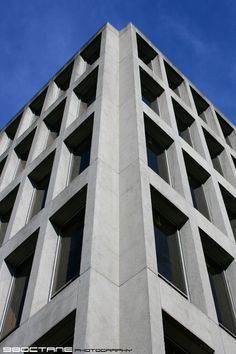Date founded 1933 | ||
 | ||
Firm type Architectural designUrban planningInterior design Dissolved circa late 1980s (1980s) Awards Simpson: RAIA Gold Medal (1997) Founders Otto Abrecht Yuncken (1945), John Freeman (1945) Buildings Sidney Myer Music Bowl (1957–1959), Cardinal Knox Centre (1969–1971), 140 William Street (1972) | ||
Yuncken Freeman, officially Yuncken Freeman Architects Pty Ltd and formerly Yuncken, Freeman Brothers, Griffiths & Simpson, was an Australian architecture firm. Founded in Melbourne, Victoria in 1933, Yuncken Freeman grew steadily, particularly from the economic boom from the 1950s to 1980s, to be a sizeable firm in Australia, with branch offices in Hong Kong as well as other parts of south-east Asia until its dissolution during the late 1980s.
Contents
The firm is perhaps best known for major public works by Barry Patten, predominately in Melbourne, and by Roy Simpson, predominately in Canberra. Some of the firm's notable projects include the Sidney Myer Music Bowl, Cardinal Knox Centre, BHP House, and the Canberra Civic Centre.
In 1997 Simpson was awarded the Royal Australian Institute of Architects Gold Medal for his significant contribution to architecture.
History
Yuncken Freeman began in 1933 when Otto (Rob) Yuncken and John Freeman left their positions as senior associates in A & K Henderson; together with Freeman's brother, Tom, and William Balcombe Griffiths, also employees at A & K Henderson. In 1945 Roy Simpson was recruited into Yuncken Freeman on the recommendation of a fellow student during his time at the School of Design in University of Melbourne.
By the 1940s the operations of the firm was disrupted by World War II, which unavoidably grew to be a much serious threat than before. Rob Yuncken and Roy Simpson eventually enlisted into service, providing planning and design services to the U.S. Army Engineers Corps. In 1946, Yuncken and Simpson returned to Melbourne only to find the members of the original group scattered. They reunited the practice. In 1947, Yuncken Freeman was appointed by the Victorian Government to initiate an emergency housing project, produced in England and to be shipped to Australia. Simpson, who had experience during his days in the U.S. Army, headed the project where he provided designs for pre-built housing that could be assembled by unskilled labour. Fifty years later, many of these emergency homes remained occupied.
By 1963 Balcombe Griffiths and Roy Simpson were the sole survivors of the five original partners, along with descendant John Yuncken, subsequently added Barry Patten and John Gates (1953), Robert Peck and Jamie Learmonth and others. Patten introduced the firm's international modernist architecture style, based on the work of Ludwig Mies van der Rohe, as seen in their 411 King Street offices, Eagle Star & BHP House. In the mid-1970s, Yuncken Freeman sacked 15 architects and the 8 directors took a 20% pay cut, only five years after completion of the State Government Offices. Patten told The Age: "The situation is very bad - there just isn't any work available. We have employed people for years and we are now finding it very difficult to keep them occupied. It is very worrying."
Major architectural works
Yuncken Freeman has designed some of Australia's landmark buildings including the following major architectural projects:
